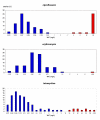Risk factors for antibiotic resistance in Campylobacter spp. isolated from raw poultry meat in Switzerland
- PMID: 14662013
- PMCID: PMC317320
- DOI: 10.1186/1471-2458-3-39
Risk factors for antibiotic resistance in Campylobacter spp. isolated from raw poultry meat in Switzerland
Abstract
Background: The world-wide increase of foodborne infections with antibiotic resistant pathogens is of growing concern and is designated by the World Health Organization as an emerging public health problem. Thermophilic Campylobacter have been recognised as a major cause of foodborne bacterial gastrointestinal human infections in Switzerland and in many other countries throughout the world. Poultry meat is the most common source for foodborne cases caused by Campylobacter. Because all classes of antibiotics recommended for treatment of human campylobacteriosis are also used in veterinary medicine, in view of food safety, the resistance status of Campylobacter isolated from poultry meat is of special interest.
Methods: Raw poultry meat samples were collected throughout Switzerland and Liechtenstein at retail level and examined for Campylobacter spp. One strain from each Campylobacter-positive sample was selected for susceptibility testing with the disc diffusion and the E-test method. Risk factors associated with resistance to the tested antibiotics were analysed by multiple logistic regression.
Results: In total, 91 Campylobacter spp. strains were isolated from 415 raw poultry meat samples. Fifty-one strains (59%) were sensitive to all tested antibiotics. Nineteen strains (22%) were resistant to a single, nine strains to two antibiotics, and eight strains showed at least three antibiotic resistances. Resistance was observed most frequently to ciprofloxacin (28.7%), tetracycline (12.6%), sulphonamide (11.8%), and ampicillin (10.3%). One multiple resistant strain exhibited resistance to five antibiotics including ciprofloxacin, tetracycline, and erythromycin. These are the most important antibiotics for treatment of human campylobacteriosis. A significant risk factor associated with multiple resistance in Campylobacter was foreign meat production compared to Swiss meat production (odds ratio = 5.7).
Conclusion: Compared to the situation in other countries, the data of this study show a favourable resistance situation for Campylobacter strains isolated from raw poultry meat produced in Switzerland. Nevertheless, the prevalence of 19% ciprofloxacin resistant strains is of concern and has to be monitored. "Foreign production vs. Swiss production" was a significant risk factor for multiple resistance in the logistic regression model. Therefore, an adequate resistance-monitoring programme should include meat produced in Switzerland as well as imported meat samples.
Figures



Similar articles
-
Prevalence and antimicrobial resistance of Campylobacter isolated from retail raw chicken and beef meat, Tehran, Iran.Int J Food Microbiol. 2006 May 1;108(3):401-3. doi: 10.1016/j.ijfoodmicro.2005.12.010. Epub 2006 Feb 14. Int J Food Microbiol. 2006. PMID: 16481059
-
Observational study of the prevalence and antibiotic resistance of Campylobacter spp. from different poultry production systems in KwaZulu-Natal, South Africa.J Food Prot. 2012 Jan;75(1):154-9. doi: 10.4315/0362-028X.JFP-11-237. J Food Prot. 2012. PMID: 22221370
-
Resistance patterns of Campylobacter spp. strains isolated from poultry carcasses in a big Swiss poultry slaughterhouse.Int J Food Microbiol. 2003 Dec 31;89(2-3):233-40. doi: 10.1016/s0168-1605(03)00152-1. Int J Food Microbiol. 2003. PMID: 14623389
-
Macrolide-resistant Campylobacter: the meat of the matter.J Antimicrob Chemother. 2007 Oct;60(4):715-23. doi: 10.1093/jac/dkm300. Epub 2007 Aug 18. J Antimicrob Chemother. 2007. PMID: 17704515 Review.
-
Prevalence and antibiotic resistance of Campylobacter, Salmonella, and L. monocytogenes in ducks: a review.Foodborne Pathog Dis. 2012 Jun;9(6):498-505. doi: 10.1089/fpd.2011.1109. Epub 2012 May 9. Foodborne Pathog Dis. 2012. PMID: 22571641 Review.
Cited by
-
Antibiotic resistance of retail food and human Campylobacter isolates on the island of Ireland from 2001-2002.Epidemiol Infect. 2006 Dec;134(6):1282-91. doi: 10.1017/S0950268806006200. Epub 2006 Apr 20. Epidemiol Infect. 2006. PMID: 16623987 Free PMC article.
-
Prevalence of Campylobacter spp. in skinless, boneless retail broiler meat from 2005 through 2011 in Alabama, USA.BMC Microbiol. 2012 Aug 24;12:184. doi: 10.1186/1471-2180-12-184. BMC Microbiol. 2012. PMID: 22920043 Free PMC article.
-
A cross-sectional study on the microbiological quality and safety of raw chicken meats sold in Nairobi, Kenya.BMC Res Notes. 2014 Sep 10;7:627. doi: 10.1186/1756-0500-7-627. BMC Res Notes. 2014. PMID: 25204564 Free PMC article.
-
PFGE genotyping and molecular characterization of Campylobacter spp. isolated from chicken meat.Iran J Vet Res. 2016 Summer;17(3):177-183. Iran J Vet Res. 2016. PMID: 27822247 Free PMC article.
-
Estimation of hazardous materials in water and their toxicity levels in Mahayel Aseer, Kingdom of Saudi Arabia (KSA).Environ Monit Assess. 2019 Nov 29;191(12):779. doi: 10.1007/s10661-019-7820-6. Environ Monit Assess. 2019. PMID: 31784811
References
-
- Swiss Federal Office of Public Health Meldungen Infektionskrankheiten. Bulletin. 2003;21:354.
-
- Solomon EB, Hoover DG. Campylobacter jejuni : a bacterial paradox. J Food Safety. 1999;19:121–136.
-
- Wistrom J, Norrby SR. Fluoroquinolones and bacterial enteritis, when and for whom? J Antimicrob Chemother. 1995;36:23–39. - PubMed
Publication types
MeSH terms
Substances
LinkOut - more resources
Full Text Sources
Medical
Miscellaneous

